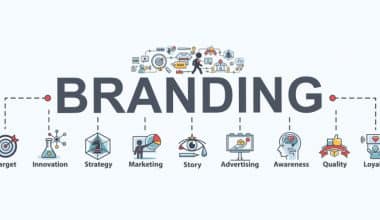Developing consistency is one of the most crucial phases in the branding process; it can boost sales by up to 30%. Companies can create a brand book to reap the benefits of consistent branding, from visual identity to tone of voice.
A brand book is more than a manual—it’s the heartbeat of your brand. It captures who you are, weaving together your values, voice, and vision. Each page tells a story that resonates deeply, guiding every touchpoint with authenticity and consistency. Your brand book is the blueprint of your identity, a living document that ensures your brand’s soul is felt in every interaction.
In this guide, we’ll explore the concept of a brand book, its purpose, and how to create one.
Key Points
- A brand book is a comprehensive document that describes a company’s brand identity, including logo, colors, fonts, and more. It’s a blueprint for maintaining brand consistency.
- A brand book can also be called a brand style guide or manual.
- Developing consistency in branding can boost sales by up to 30%. A brand book helps maintain this consistency across visual identity and tone of voice.
- The primary purpose of the brand manual is for employees, partners, and collaborators to ensure everyone aligns with the brand’s vision and values, maintaining consistency in communication and presentation.
What Is a Brand Book?
A brand book is a document used to describe your company’s brand identity. It is a comprehensive guide in which you describe the look of your brand’s identity, including your logo, colors, fonts, typefaces, images, sounds, smells, and materials.
Above all else, it is a DNA blueprint with layers of details, from the more general—brand purpose—to the more intricate nuances, such as specifics regarding the colour scheme and fonts. Combined with these elements, a comprehensive brand manual is born, providing staff and customers with a clear vision of the company and its product. Every big-name brand has a brand book, from Apple to Google to Coca-Cola, but even smaller-scale brands benefit from having one.
Components of Brand Book
So, what content should go into your brand book? Of course, your brand book may include essential brand-specific information, but some key components are must-haves. Let’s discuss what they are.
#1. The Cover
Like any other book, your brand guide’s cover is its first and most significant opportunity to leave a positive impression on readers (i.e., your team and collaborators). Design your brand manual cover with that in mind and cover essential information in a friendly and straightforward tone. Also, show basic information about your brand, including these elements:
- Company name
- Company logo
- Title of the book
- Date published
#2. Content Guide
By including a content guide or table of contents page, you can ensure readers won’t waste time trying to discover what they’re looking for. This page should include a high-level summary of everything customers can anticipate finding in the brand book.
This table of contents can be interactive and clickable, appearing in a sidebar or at the top of the site. The idea is to make navigation around the brand manual efficient and user-friendly.
#3. Your Brand’s Name and History
Storytime! This is where you invite readers in by introducing the company’s origin story, mission statement, and core values. Keep it brief and informative, but give them a reason to believe.
Telling people how your brand became a reality is an excellent opportunity to catch their attention. To make your visual storytelling even more enjoyable, you can use different formats to talk about your brand’s history, such as:
- Timeline
- Images
- Videos
- Quotes
Frito Lay, for example, has everything on its website: history, logos, brands, and downloadable material.

#4. Logo
Logos are considered the most recognizable symbols of a brand. Be sure to dedicate at least one page of your book to explain your logo’s history, usage, and variations.

#5. Color Scheme
The visual aspect of your marketing that you employ the most will be the colour palette associated with your brand. Provide the precise HEX and RGB codes that should be utilized consistently and correctly.
A clearly defined colour scheme will benefit your design and marketing teams and any outside contributors or contractors who assist you in creating assets for your brand. Maintaining consistency in this scheme will help fortify your brand identification across all your brand materials. This way, your brand will stand out in the marketplace and differentiate from competitors.
#6. Typography
Fonts are how you communicate your message—pick the wrong one, and readers may misinterpret your content. Ensure to include examples of various typefaces available to your brand to help designers choose the right one.
This part of your brand manual should include typography specs such as:
- Fonts and font families
- Proportions and sizes
- Spacing
- Capitalization
Focusing on such detailed technicalities will require effort when creating the brand book, but it will leave no room for doubt and save you from unnecessary misinterpretation.
#7. Tone of Voice
Your brand’s voice is a crucial asset. Explain how you want your company to sound when communicating with customers, and provide examples of how to do it in different contexts.
Your tone of voice plays a crucial role in storytelling. Forming a deep and emotional connection with your customers will eventually lead to greater engagement.
Read more: TONE OF VOICE: What It Is, Why It Matters, and How to Define Your Brand Voice
Why Create a Brand Book?: Its Purpose
In most cases, you don’t create a brand book for consumers but for your employees, partners, and potential collaborators. Some companies, such as video game companies that encourage users to produce their mods and material, might want to display it to the readers, mainly if they depend on customer participation. Involving your customers in your content is one of the best ways to create consumer passion and engage them in your brand.
Creating a brand book in which you state all the values and standards associated with your brand will ensure that your people—especially your marketing team—will know from the start what language to use, the design rules they must follow, and the principles and values you apply to your business, which is essential for your brand’s strategy as well. You and your workers must be on the same page when expressing your company’s vision. Using your brand manual in other projects, like your sales enablement processes, can be beneficial.
Regardless of the size of your business, a powerful brand book will enhance how your complete brand story is presented. It will enable you to give your target audience the most comprehensive and unique illustration of your brand.
What Is the Difference Between Brand Book and Brand Guideline?
You must be thinking of this question after you have grasped what a brand book is and why it is essential to create one.
A brand book inspires and helps keep people aligned with your organization’s purpose or core idea, helping them think, communicate, and act from that purpose as a starting point. A brand guideline helps the people inside and outside your organization use your visual brand assets consistently and correctly.
As you can see, a brand book is geared more toward meaning and inspiration, while a brand guideline is geared toward maintaining visual brand consistency. Together, the two documents form a significant part of your brand guidelines. They are the logbook for a brand’s identity. They are not just a document that collects information about your brand. Brand guidelines are crucial to brand alignment.
Storing brand guidelines on a PDF document and repeatedly sharing updated versions will lead to misalignment because there are so many versions. It will become a hassle for your colleagues to find out which file is correct and whose hard drive is on.
Suppose all your stakeholders know where to find your brand guidelines. In that case, what they are and how they apply to their specific roles, you have achieved brand alignment, a critical measure of customer attraction and satisfaction.
Who Should Invest In A Brand Book?
A brand book is essential for any company or organization that wishes to create and preserve a recognizable brand identity.
Businesses competing in markets where it might be challenging to stand out and set one brand apart should consider investing in a brand book. By establishing a solid and consistent brand identity, businesses can build customer trust and credibility, increase brand recognition, and drive sales and revenue.
Whether you’re a small business or a large corporation, a brand manual can ensure that everyone in your organization is aligned and consistently communicating with your audience.
How to Create a Brand Book
Any company that wants to stay relevant in today’s market should know that brand books are an essential, non-negotiable asset. It’s not whether you should create a brand book but how.
Below is a comprehensive checklist to help you create a thorough and effective brand book.
How to Create a Brand Book Checklist
Brand Book Examples
A great way to get inspired and learn more about brand books is to look at examples. Here are 7 best brand book examples for your inspiration from well-known brands:
#1. Nike
Nike’s brand book features bold, high-contrast photography and a simple, direct writing style that reflects the brand’s ethos of empowering athletes of all levels.
Nike’s brand book emphasizes the importance of innovation, performance, and authenticity, which are fundamental values around the brand’s identity.
The guidelines provide clear examples of how the brand’s visual and verbal elements should be used in various contexts, such as marketing materials, product packaging, and digital platforms.

#2. Coca-Cola
Coca-Cola’s brand book is classic and timeless. It focuses on the brand’s iconic red and white colour scheme and its long-standing tradition of spreading happiness and positivity.
One notable aspect of the Coca-Cola brand book is its emphasis on storytelling.
The brand’s guidelines stress the importance of storytelling in connecting with consumers and building emotional connections with them. Coca-Cola’s brand book also includes guidelines for engaging with consumers on social media and creating content that reflects the brand’s identity.

#3. Samsung
Samsung is a diversified brand with multiple subdivisions, each with its own standards. Its brand book (from 2015, but still relevant) outlines the standards that define this brand and is an “evolving source for consistent communications across a wide audience of consumers and agencies.”
The brand stylebook contains elements such as proof points and archetypes, which discuss visual standards through various examples and Samsung’s personality.
It also specifies:
- Logotypes
- Master logo
- Logo variations
- Device logos
- Campaign logos
- Color palette
- Typography
- UI elements
- Backgrounds
- The role of photography
- Tone
- Terminology
Besides these pretty standard features, Standard Mobile also has specific requirements regarding product presentation. Their brand book discusses requirements for device angles, poses, and composition.
#4. Amazon
Amazon’s brand usage guidelines emphasize the importance of proper brand usage as one of the company’s most valuable brand assets.
The firm allows advertisers to use Amazon branding elements within the requirements specified in the document. Advertisers must also submit the material they intend to use to Amazon for approval.
Amazon’s guidebook outlines:
- Call to Actions and Amazon text link CTAs that should conform to standards in typeface and sizing, graphical styling, colour, and.com usage
- Branded button CTAs
- Capitalization and punctuation
- Brand phrases
- Branding on and off the Amazon site
- Logos and imagery
- Clear space
- Icons and site elements
- Product Imagery
#5. Mailchimp
Mailchimp’s brand book design is colourful and playful. It focuses on approachable language and vibrant illustrations that reflect the brand’s fun and quirky personality.
The Mailchimp brand book emphasizes the importance of understanding and connecting with the brand’s target audience: small businesses and entrepreneurs.
It also highlights the importance of storytelling, authenticity, and community building to the brand’s identity.

#6. Lancome

This personal care and beauty brand has a brief brand-style book that opens with an introduction and a story about a brand’s longevity, values, and mission. Claiming its pivotal role in skincare innovation, the company sets the tone in these opening lines by citing its brand ambassadors and accessibility worldwide as some of its most vital points.
The brand manual moves on to define these elements as essential for its employees and marketing campaigns:
- Logo
- Brand colors
- Typography
Lancome’s brand style guide is significantly more concise than the other brands on this list. This is because the mentioned elements are uniform and don’t vary too much across different channels. Also, this minimalistic approach enhances exclusivity, giving an air of luxury to a mass product.
#7. Uber

The world’s number one ride-hailing app has a stylish brand book that contains nine core elements:
- Logo
- Colour
- Composition
- Iconography
- Illustration
- Motion
- Photography
- Tone of Voice
- Typography
Each takes up its section in the brand book and explains how every core element should be constructed for consistency.
For instance, Uber specifies that its primary colour, which is its global association with the brand, is black. The company also defines a range of secondary and tertiary colours to work with black in alternate logo versions.
The brand book also contains guides on logo construction, clearspace, scale, placement, and typeface. Uber is very detailed in determining its unique tone of voice for all touchpoints. They define consideration, simplicity, and consistency as the fundamental values of their messaging and sound optimistic, inviting, and bold.
What Is Another Name for a Brand Book?
Another name for a brand book is a brand style guide or brand manual. These terms are often used interchangeably to describe the document outlining a brand’s visual and messaging guidelines.
Do You Need a Brand Book?
A brand book is essential for any business or organization that wants to maintain a consistent and professional brand identity. Here are some key reasons why you need a brand book:
- Consistency Across Platforms: A brand book ensures that all visual and messaging elements are consistent across different platforms, including print, digital, and social media. This consistency strengthens brand recognition and trust among your audience.
- Clear Communication: It provides guidelines for how your brand should be represented, ensuring everyone, from designers to marketers, understands and follows the same rules. This prevents miscommunication and errors in how your brand is presented.
- Professionalism: A well-crafted brand book reflects professionalism and attention to detail, which can positively influence how customers, clients, and partners perceive your brand.
- Brand Integrity: A brand book helps protect your brand’s integrity by defining specific guidelines for logo usage, color palettes, typography, and tone of voice.
- Efficient Onboarding: A brand book is an invaluable resource for new team members. It helps them quickly understand and adapt to the brand’s guidelines, ensuring they contribute to a cohesive brand experience.
Bottom Line
The logos, colours, and messages we know and recognize are all brand identity products. A brand book must also ensure your company’s message is conveyed consistently across all platforms by capturing and communicating your brand’s identity to prospective clients. With the correct format and content, you can create a comprehensive and cohesive guide to increase readers’ understanding of your company and its values.
Wishing you luck!
Similar Articles
- Small Business Branding Ideas: 15 Creative Ideas for 2024
- Building Effective Content Pillars: A Guide for Nigerian Brands
- Keep Your Brand at the Top With These 7 Evergreen Marketing Campaign Ideas






